Visual material
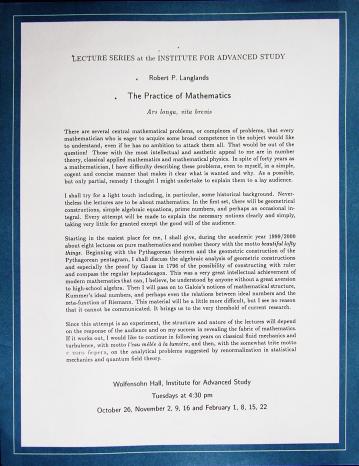
The talks were recorded at the Institute and may be found along with lecture notes at https://www.ias.edu/math/practice
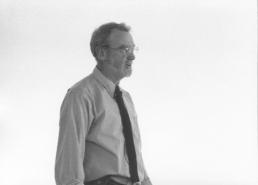
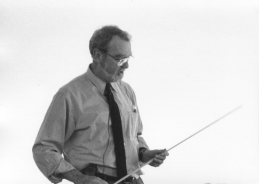
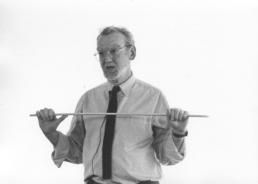
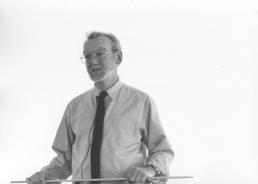
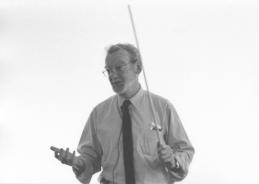
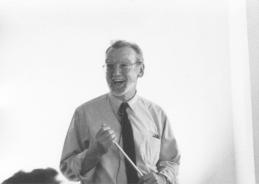
(Photographs taken by C. J. Mozzochi in one of the lectures)
There are at several aspects of Harish-Chandra, his life, and his work on which one can reflect: his personality; the nature of his contributions and their position in mathematics; his relation to the land of his birth.
It would have been in 1961--62, as I was beginning to reflect on the trace formula of Selberg and, in particular, attempting to evaluate the integrals that arise when using it to calculate the dimension of the space of automorphic forms, that David Lowdenslager, a young mathematician at Princeton University who not long afterwards met an unfortunate accidental death, suggested to me that it was becoming accepted that the papers of Harish-Chandra, who had begun his prolific career just a few years before, might be pertinent. Among other things his first papers on the holomorphic discrete series had already appeared. I began to read them and to reflect. It did not take long until one day, on the brief walk home from the mathematics department at Princeton University---the spot is still there, not yet buried under still another building, or still more asphalt paving---I recognized that the integral with which I was attempting to deal was an orbital integral of a matrix coefficient of a representation in the holomorphic discrete series and therefore, according to a theory familiar for finite groups from the time of Frobenius, given by the value of a character.
An aside: for those who know Princeton, I observe that the street on which we lived was Bank Street, a short street, one block long, a kind of extension of University Place on the other side of Nassau Street. I discovered some time later that Harish-Chandra had earlier, when he came to the IAS with Dirac, also lived on that street, but in a rented room. My wife and I lived in a house that was all our own, although we rented it and did not own it. We had a small garden and, by the time, we left four children, three when we arrived. We were very pleased with the surroundings---there were fewer automobiles then than now and the two older children could walk unaccompanied to school. So I was surprised, even dismayed, when a visitor to Princeton University, a mathematician from England, a topologist whose name would be familiar to you if I could remember it, commented on the `mean streets' to the north of Nassau meaning, among others, our Bank Street. I still have fond memories of our time there, where in particular in 1963--64, I worked evenings on the notes for the theory of Eisenstein series, and make a point of walking along Bank St. whenever I am going in that direction, to the wine shop or to the public library.
An afterthought: many years later Harish-Chandra and I were with our families actually neighbours but on Battle Road in Princeton, just a short walk from the Institute. It is a street with its own merits, above all the sycamore trees, but of quite a different nature than Bank Street.
At some point, I had written Harish-Chandra, requesting reprints---at that time still printed, still collected, and still useful---but he had not responded. He was at the Institute in Princeton, but at that point, as a visitor. He returned as a permanent member and professor a year or two later. While there as a member, he attended regularly the Current Literature seminar organized by André Weil and one day at the seminar, having, I suppose, been apprised, perhaps by Salomon Bochner, of my existence and, I suppose, of whatever promise I had, he spoke to me and proffered the desired reprints.
At that time, it was generally conceded that Harish-Chandra's work was important. At the same time it was considered difficult and seldom, if ever, studied. So I immediately achieved a certain fame: I could read and apparently understand his papers. That meant: (i) I could serve as a referee; (ii) I could serve as a reviewer; (iii) and, as the most demanding obligation, serve as a silent interlocutor, who could listen to him as he described, on his long daily walks, his latest discoveries. This was not problematic as long as I was elsewhere, when he was at Columbia and I at Princeton, or he at Princeton and I in Turkey or at Yale, but when I came as a colleague to the IAS in 1972, I had to persuade him, without offending him, that I had projects of my own to which I hoped to attend.
There are now excellent introductions to his work, like those of Knapp. I fear that they are not so widely read as they and the contributions of Harish-Chandra deserve.
He was at the Institute and in its School of Mathematics a valued colleague, sober, reflective, with the interests of the Institute and the School at heart. My colleagues were not all of this stamp. His early death was a great loss in many respects. I add that although I owe the beginnings of my professional career to Edward Nelson, who had me appointed without any formal application or any documents at all as an instructor at Princeton right out of graduate school at Yale, and, above all, to the encouragement and suggestions of Salomon Bochner, I also have a great deal for which to thank Harish-Chandra. Later, in 1965--66 at a time when I was just coming out of a period of discouragement, the result of a not very fruitful year in California, Harish, as he told me, proposed to the other mathematicians at the IAS that I be asked to join their ranks. They were not favourable, but that I stood so high in Harish-Chandra's regard was a tremendous complement that I cherish to this day. He was able to persuade them after a few years, and considerable efforts, especially his lectures in 1967--68 on Eisenstein series for rank-one groups, to accept me. He told me once that Weil was persuaded by my extensive use of the Weil group.
This was to be a brief talk, but there is one point on which I would like to insist. Harish-Chandra was one of the very best, one might even say one of the greatest, but this is a word that frightens me, mathematicians of the second half of the twentieth century. It would be worthwhile to reflect on just where he stands. This is difficult for me, probably impossible, because any judgement demands a judgement of the domains in which he has worked and these are also the domains in which I have spent my efforts. So I am, almost inevitably, prepossessed in their favour and in his favour. Their study demands a serious familiarity with various aspects of analysis---differential equations and spectral theory, of algebra---semi-simple or reductive groups, and their applications, as well as familiarity with geometry and number theory, even of algebraic geometry. So there are rather few genuinely competent practitioners. None the less there is a tradition of outstanding practitioners in the theory of Lie groups and their representations, among others: Dedekind, Sophus Lie, Elie Cartan, F.G. Frobenius, Issai Schur, C.L. Siegel, Hermann Weyl, Erich Hecke. How does Harish-Chandra compare with them? How does he compare with others in fields, like number theory or algebraic geometry, with more practitioners and a larger audience? A definitive answer is out of the question but some reflection along these lines would be instructive.
I observe, as an aside, that the key to the study of general Shimura varieties, after their algebro-geometric definition, is Harish-Chandra's theory of the discrete series supplemented by Wilfried Schmid's generalization of the Borel-Weil-Bott theorem to non-compact groups. Although the Wikipedia presentation of Shimura varieties improves with time, the authors of the present text, presumably algebraic geometers or number theorists, continue to be unaware of this and otherwise inadequately informed about the history and nature of the subject, even the source of its name.
Another topic, too complex to be considered today but as yet, largely ignored, is the development of the local aspects of the geometric theory of automorphic forms, thus in some sense, but only in some sense, of the representation theory of $G(F)$, where $F$ is the ring of formal Laurent series with singular part of finite length. It has, so far as I know, not yet been touched in a serious way, but it is a natural extension of the theory of spherical functions on $G(\mathcal O)\backslash G(F)/G(\mathcal O)$ and is suggested by the rudiments of a geometrical theory available at the moment.
My preference as a mathematician is for theorems that follow from theories: the law of quadratic reciprocity from the theory of the cyclotomic equation $z^n-1=0$; the Chern-Gauss-Bonnet theorem in differential geometry; Fermat's theorem from the theory of automorphic forms. I like to think that the Riemann Hypothesis and similar hypotheses will follow some day from the general theory of automorphic forms and their $L$-functions. Harish-Chandra was one of the pioneers, not the first but perhaps the major one, in the theory of representations of reductive groups, both compact and non-compact, one of many essential components of the theory of automorphic forms. I hope he will be remembered as such.
Harish-Chandra's relation to India and in particular to the Indian past and to Indian culture, I do not understand. The obvious, but not the only reason, is my unfamiliarity with it. I observed once that Harish-Chandra's work on harmonic analysis was largely built on his command of advanced calculus. Some supplementary information about Lie groups was of course demanded. This reliance on essentially elementary techniques reflects not his curiosity about mathematics, a curiosity that was apparent when he arrived in Princeton with Dirac in 1947, but his education. Whether he never returned to India in a serious professional way because at that time there was no place in India for someone with his professional ambitions I do not know. I, myself, as a Canadian, am familiar with the misunderstandings that arise with colleagues or administrators who are unaware of what one might have in mind, even if it is only as a hope or just an innate impulse, or who regard it as an entirely inappropriate presumption. There are, of course, colleagues and administrators of the same stamp in the USA and elsewhere. I have met them, but, in my experience, there is more space to move around them in the USA.
Harish-Chandra was also, as everyone knows, very focussed, although he came from a North Indian family of some prominence with some attachment to Indian culture. His mother was, I understand, fluent in Hindi, Urdu and Farsi. Harish, in a casual conversation, once mentioned to me that she was dismayed by the decaying quality of the Hindi spoken by the younger generation, but that, and with this he seemed to be pleased, his she thought considerably better than the average. He also said to me, on this or another occasion, that he felt that one language was enough for anyone! I was surprised then by the statement; I am surprised now. I do not understand what he was trying to say. I prefer to believe that he himself was misled, but how and why I do not know. It may have been just one aspect of his ascetic tendencies.
Thank you for listening.
Video of comments:
Author's comments: There are one or two comments I neglected to make in the course of the lecture or matters that were inadequately explained.
- (i) The functions to be used in the proof proposed for functoriality are, at least initially, sums of logarithmic derivatives of automorphic \(L\)-functions,
\[ -\sum_{\pi^{{\mathrm{st}}}}m(\pi^{{\mathrm{st}}})\frac{L'(s,\pi,\rho)}{L(s,\pi,\rho)}=\sum_{n=1}^\infty\frac{{\mathrm{tr}}_{{\mathrm{st}}}(f_n)}{n^s}, \]
so that \(n\) actually runs over powers \(p^k\), \(k > 0\in\mathbf Z\), of primes. If the base field is not \(\mathbf Q\), it runs over powers of prime ideals \(\mathfrak p\). Indeed finitely many \(p\), \(p_1,\dotsc,p_k\), or finitely many \(\mathfrak p\), \(\mathfrak p_1,\dotsc,\mathfrak p_k\) may be excluded. The function \(f_{p^k}\) is the convolution of a spherical function at \(p\) and an arbitrary smooth, compactly supported function in \(\prod_{k=1}^sG(F_{p_k})\), inserted so that the final result of the limiting process is applicable to individual classes of (cuspidal) automorphic representations. This second function is independent of \(n\). The stable multiplicity \(m(\pi^{{\mathrm{st}}})\) is the multiplicity of the \(L\)-packet. The simplest example of this multiplicity is provided by \(\mathrm{SL}(2)\) and is discussed in the paper of Labesse-Langlands. The stable trace is that given by the stable trace formula, something whose existence I take for granted here! -
(ii) Although I did not insist on it in the lecture, the notion of stable transfer, introduced with the example of \(\mathrm{SL}(2)\) in the paper Singularités et transfert, will be, I am convinced, an important feature of the trace formula.
-
(iii) I observe that no notion of reciprocity is suggested for the geometric theory, neither over a finite field nor over \(\mathbf C\). One might ask whether this might exist and might involve one-parameter families of motives. I have never done so!
-
(iv) I believe I was sufficiently clear in the videos. I repeat here none the less that although the suggestions implicit in (ii) and (iii) of the text problems-45-years-later-oxford_rpl.pdf demand a broad understanding of a number of different fields and, for some, a conceptual veering, as well as time and effort, they are not excessively daunting, whereas (i) and (iv) will demand more courage and talent than many of us have. I would hesitate to make, at this point, any very precise assertion, but as I reflect on the lecture the possibility of a more intimate relation than first envisaged between the Yang-Mills connections and the connections constructed from the Hecke eigenfunctions begins to suggest itself. I am still very uneasy with the former. It may be that the relation not only exists but also is well-known in some circles. At the moment, however, I have no reason to think so.
-
(v) Although Hecke operators appear nowhere in it, I have found the paper of Atiyah-Bott otherwise an excellent, as well as a rich, source of information about the geometry of \({\mathrm{Bun}}_G\) and the connections on the two spaces \({\mathrm{Bun}}_G\) and \({\mathrm{Bun}}_{{}^LG}\). It is not, however, easy to read, and for anyone who does not possess a good deal of geometric and topological facility even more difficult. Moreover, the authors have been intimidated by the algebraic geometers' emphasis on stable bundles, so that some aspects of the geometry that are important in the context of the videos are not discussed. It is, nevertheless, instructive to be forced to reflect on these matters on one's own.
-
(vi) The purpose of my final comments was perhaps not clear. I am repeating a suggestion made elsewhere, also by me, that what is now, unfortunately and inappropriately, often referred to as the Satake parameter be called the Frobenius-Hecke parameter.
-
(vii) I draw attention here to an absence in the video, that is also an absence in the ``program.'' Although I began the study of automorphic forms on listening to the lectures of Steven Gaal on a paper of Selberg's, I was soon led to the papers of Siegel and Harish-Chandra. Among other things, Siegel's papers were often concerned, in one way and another, with theta-series. His techniques were formalized by Weil as the metaplectic group, a topic that was very popular for a while in the sixties and seventies of the last century, partly because it allowed the proof of functoriality (under the unfortunate label ``lifting'') in a number of special cases. With the appearance of the notion of functoriality and the possibility of using the trace formula to prove it, the metaplectic group has faded into the background, in part, at least in my view, rightly so. It and the associated automorphic forms of half-integral weight are nevertheless there and are not accounted for by the theory of automorphic forms adumbrated in the video. So something appears to be, or may be, lacking.
-
(viii) For comments on the relation between ``universality'' and ``conformal invariance'' from someone who has struggled with these questions in a concrete way and with considerable success I suggest Towards conformal invariance of \(2D\) lattice models and other papers of Stanislas Smirnov.
Videos of lectures:
- Part 1: https://youtu.be/dYDg4LLDA8A
- Part 2: https://youtu.be/5hURoIzhTuM
- Part 3: https://youtu.be/Jj5VARzgVpY
Author's comments: I took the occasion of the Mostow conference in New Haven on October 23 to discuss my still provisional reflections on the geometric theory, thus for the second part of the Prologue. The best I can offer in the way of a geometric theory with which I would be pleased is a sketch of the principal difficulties to be overcome. There are many. The importance for me is the very strong analytic flavour of the theory I hope to construct or see constructed.
Video of lecture: